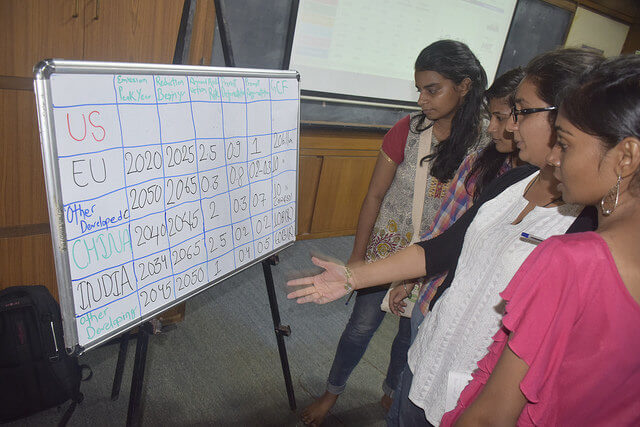Tips on how to Customize World Climate for Different Audiences
By
Grace Mwaura
January 19, 2018
Laura Tucker, from Jefferson County, Washington, shares her tips of facilitating World Climate with middle schoolers and adults in 2017.

Participants at a past World Climate event. © Bindu Bhandari
I was asked by the local Unitarian Church to offer a climate change class for their adult learning program. After watching an introductory video about C-ROADS, I thought World Climate would be the ideal way to start the class. I agreed with Climate Interactive’s assertion that you can run the simulation without having all the science behind climate change.
1st Tip: Test
I decided to try out the simulation with high school students first before using it in an adult class since the students would give me honest feedback about how it went. It would also allow me to adapt the simulation to my adult audience as well as get some good practice before teaching it to a group with high expectations.
I ‘borrowed’ three 10th-grade classes who would study climate change later in the year. I was amazed at how well it went with no prior instruction. It took a little while for them to figure out how to negotiate, but once they got the hang of it, and had the right students in charge, they did exceptionally well. There wasn’t enough time in the class to allow for a second round of negotiations, so the pressure was ‘on’ to get it right the first time. The students all rose to the challenge. I was fascinated at some of their ideas.
One group representing the European Union decided that deforestation was a huge issue and offered the Developing Nations $1 per tree not to cut them down. I suggested they get some data about the number of trees that would be cut to get a dollar figure. They hit the internet. It was billions. The next thing I heard was that they were offering $33 billion to The Green Climate Fund. I asked where they were getting that figure and they responded it was what the EU spends on defence. They felt the Green Climate Fund was a much better ‘buy’. That took my breath away.
Of the three classes, two got their emissions down to just over 2°C of warming. One group actually got their emissions low enough to ‘save the world’ with only 1.75°C of warming! In soliciting their feedback during the debrief session, I asked the students what they thought the adults would do when they played the simulation the following week. The students were worried that the adult group wouldn’t get serious about negotiating and would let the world ‘cook’. I reminded them that the adult group was a bunch of Unitarians, and I would let them know if their prediction was accurate.
2nd Tip: Animate the roles
The next week, I started the adult climate change class with the C-ROADS simulator. As a way to get to know one another, I made name tags for the participants with the name of their country or countries and the relative CO2 footprint per capita of that group in a coloured bubble with relative size to the others. For example: -
- United States - 17 tons
- Other Developed Countries – 10.5 tons
- China – 7.7 tons
- European Union- 6.9 tons
- Other Developing Countries – 2.5 tons
- India - 1.9 tons
It was a great way to identify what country each person represented and also see the relative carbon footprint per person in that country or group of countries. Great visual!
3rd Tip: Customize the slides
I also edited the slide show and used some of my own slides to augment points I felt were important to this audience. I always include a visual of the Greenhouse Effect to make sure all participants understand that fundamental part of climate change. One the negotiations started, the group jumped right in to the negotiations and the room was very animated from the start. I found the adults were taking their roles quite seriously. Some were unwilling to budge on what they perceived to be the country or countries’ perspective. The confidential briefings provided by World Climate were extremely helpful.
4th Tip: Allocate time for deep dive
One addition I found necessary was to have some networked computers available for fact-checking and information gathering. They were used extensively during the simulation.
After two rounds of negotiations, it turned out that the students were right. The adults held on to their country’s (countries’) needs and wouldn’t back down, keeping warming at 4+°C. In our debrief, it took the whole group to come out of their roles and reach some conclusions about emissions in order to keep warming under 2°C. Mostly, that involved the U.S. capping their emissions quickly and drawing down even faster. They were amazed at how much that made a difference, and how little a difference the European Union made. The idea of relative CO2 output was made real!
I will use this simulation again! It seems to work beautifully as a stand-alone activity, or as the kick-off to a course on climate change. I deeply appreciate all the hard work Climate Interactive has done in order to make this so successful!

